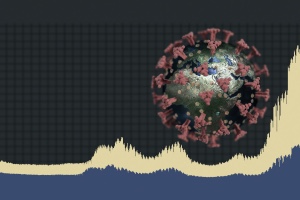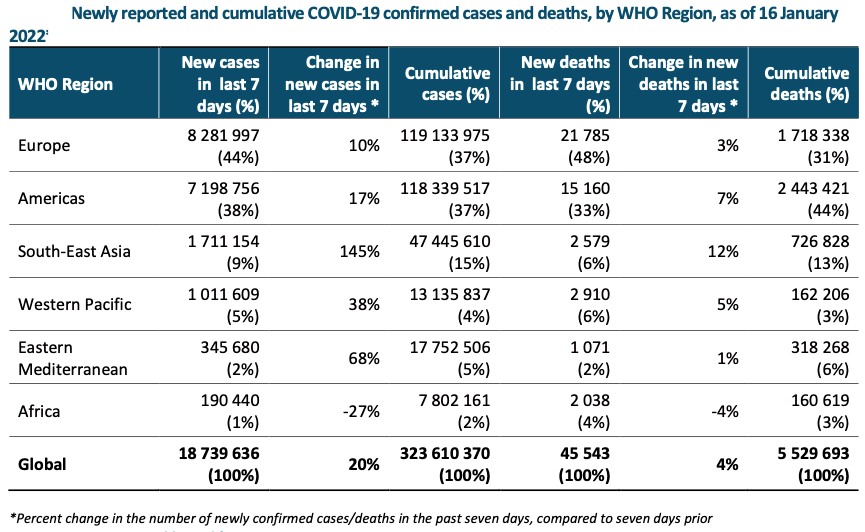
Geneva: Globally, the number of new COVID-19 cases increased in the past week (10-16 January 2022), while the number of new deaths remained similar to that of the previous week. Across the six WHO regions, over 18 million new cases were reported this week, a 20% increase, as compared to the previous week. Over 45 000 new deaths were also reported. As of 16 January, over 323 million confirmed cases and over 5.5 million deaths have been reported worldwide.
“The number of deaths remains stable for the moment but we are concerned about the impact Omicron is having on already exhausted health workers and overburdened health systems. In some countries, cases seem to have peaked, which gives hope that the worst of this latest wave is done with, but no country is out of the woods yet,” Dr. Tedros Adhanom Ghebreyesus, Director-General, World Health Organization, said here. He expressed his concerns about many countries that have low vaccination rates, as people are many times more at risk of severe illness and death if they’re unvaccinated.
“Omicron may be less severe, on average of course, but the narrative that it is mild disease is misleading, hurts the overall response and costs more lives. Make no mistake, Omicron is causing hospitalizations and deaths, and even the less severe cases are inundating health facilities. The virus is circulating far too intensely with many still vulnerable,” he said.
Also read: India reports over 2.64 lakh new Corona cases in 24 hours
WHO warned today that for many countries, the next few weeks remain “really” critical for health workers and health systems. It stated that still the impact of the current wave could be significantly reduced by sharing and using health tools effectively and implementing public health and social measures.
Dr. Ghebreyesus said at a time of Omicron, it remains more important than ever to get vaccines to the unvaccinated. “Vaccines may be less effective at preventing infection and transmission of Omicron than they were for previous variants, but they still are exceptionally good at preventing serious disease and death.” He further informed that WHO could track new variants like Omicron and this virus’ evolution in real time because of efforts of thousands of scientists and experts around the world. “More than 7 million whole genome sequences from 180 countries have now been submitted to GISAID, which was initially set up to track flu,” he said, adding that new formulations of vaccines were being developed and assessed for how they perform against Omicron and other strains.
“This pandemic is nowhere near over and with the incredible growth of Omicron globally, new variants are likely to emerge, which is why tracking and assessment remain critical,” he said.
Meanwhile, despite a slowdown of the increase in case incidence at the global level, all WHO regions reported an increase in the incidence of weekly cases with the exception of the African Region, which reported a 27% decrease. The number of new deaths reported in the Region too was just over 2000, similar to the number reported during the previous week. The highest numbers of new deaths were reported from South Africa (907 new deaths; 1.5 new deaths per 100 000 population; a 23% decrease), Ethiopia (111 new deaths; <1 new death per 100 000; a 52% increase), and Namibia (106 new deaths; 4.2 new deaths per 100 000; a 63% increase).
The South-East Asia Region, that also comprises India, reported the largest increase in new cases last week (145%), followed by the Eastern Mediterranean Region (68%). New weekly deaths increased in the South-East Asia Region (12%) and Region of the Americas (7%) while remaining approximately the same as the previous week in the other regions.

At the country level, the highest numbers of new cases were reported from the United States of America (4 688 466 new cases; similar to previous week’s figures), France (2 012 943 new cases; a 26% increase), India (1 594 160 new cases; a 150% increase), Italy (1 268 153 new cases; a 25% increase), and the United Kingdom (813 326 new cases; a 33% decrease).
In the Americas, with over 15 000 new deaths, the number of new deaths showed a 7% increase as compared to the number reported during the previous week. The highest numbers of new deaths were reported from the United States of America (10 412 new deaths; 3.1 new deaths per 100 000; a 5% decrease). In Europe, the number of weekly deaths was similar to the previous week, with over 21 000 new deaths reported. The highest numbers of new deaths were reported from the Russian Federation (5157 new deaths; 3.5 new deaths per 100 000; a 9% decrease), Poland (2563 new deaths; 6.8 new deaths per 100 000; a 19% increase), and Italy (1975 new deaths; 3.3 new deaths per 100 000; a 44% increase).
In WHO’s South-east Asia Region, over 2500 new weekly deaths were reported, which was a 12% increase as compared to the previous week. The highest numbers of new deaths were reported from India (2276 new deaths; <1 new death per 100 000; a 13% increase), Thailand (100 new deaths; <1 new death per 100 000; a 5% decrease), and Sri Lanka (92 new deaths; <1 new death per 100 000; an 8% decrease).
The numbers of new weekly cases and deaths have continued to increase in WHO’s Western Pacific Region, with over one million new cases and over 2900 new deaths, increases of 38% and 5% increase respectively as compared to the previous week. Twelve countries in the Region (44%), reported increases of over 10% in new cases, with the highest increases reported from Palau (46 vs 5 new cases; an 820% increase), French Polynesia (475 vs 109 new cases; a 335% increase) and Japan (95498 vs 23168; a 312% increase). The highest numbers of new cases were reported from Australia (472 564 new cases; 1853.2 new cases per 100 000; a 12% increase), the Philippines (231 502 new cases; 211.3 new cases per 100 000; a 159% increase), and Viet Nam (131 468 new cases; 135.1 new cases per 100 000; similar to the previous week’s figures). The highest numbers of new deaths were reported from Viet Nam (1363 new deaths; 1.4 new deaths per 100 000; a 10% decrease), the Philippines (723 new deaths; <1 new death per 100 000; a 23% increase), and Australia (288 new deaths; 1.1 new deaths per 100 000; a 213% increase).
The Eastern Mediterranean Region also showed a substantial increase in new cases reported during this past week, with over 345 000 new cases, a 68% increase as compared to the previous week.The highest numbers of new cases were reported from Morocco (46 104 new cases; 124.9 new cases per 100 000; a 45% increase), Lebanon (45 231 new cases; 662.7 new cases per 100 000; a 19% increase), and Tunisia (39 487 new cases; 334.1 new cases per 100 000; a 194% increase). The number of new deaths remained similar to the number reported during the previous week, with just over 1000 new deaths reported. The highest numbers of new deaths were reported from the Islamic Republic of Iran (197 new deaths; <1 new death per 100 000; a 5% decrease), Egypt (185 new deaths; <1 new death per 100 000; a 9% increase), and Tunisia (122 new deaths; 1.0 new deaths per 100 000; a 54% increase).
– global bihari bureau





